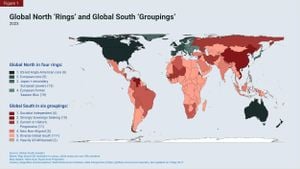India's stock market is currently experiencing significant turbulence, driven largely by rising inflation and substantial foreign fund withdrawals. Recently, the Nifty 50 dropped by 1.1%, reaching 23,616.40 points, marking over a 10% decline from its recent peak. The declines are sweeping across major stock sectors, including small-cap and mid-cap indices, which have fallen even harder. Retail inflation has spiked to its highest level in 14 months, forcing investors to rethink their strategies and brace for potential consumer spending slowdowns.
Market analysts are urging caution as both the Nifty and other indices entered correction territory, with overall corporate earnings reportedly falling short of expectations. The Sensex has shown vulnerability, especially as it dropped 1,805.2 points or 2.27% over just two days, relinquishing investor confidence gained during previous market rallies. This downturn coincides with wider economic concerns, including worries about inflation affecting monetary policy decisions from the Reserve Bank of India’s Monetary Policy Committee.
The backdrop to this decline may be due to broader global economic disturbances. Recent U.S. inflation data, showing persistent consumer price increases, has sparked fears of tighter monetary conditions, leading foreign investors to withdraw nearly $15 billion from Indian equities over the past 33 sessions. Such outflows are fueling apprehensions over the liquidity and stability of Indian financial markets.
Investors are increasingly concerned about the prospects of the market as rising inflation diminishes the likelihood of interest rate cuts by the Reserve Bank of India. The market correction reflects the pressure central banks globally face as they balance growth with inflation. This situation is exacerbated by concerns around geopolitical events as well, adding to the uncertainty plaguing investors.
The economic environment has posed challenges for Indian corporates as well, with many facing hurdles from higher operational costs due to inflation. Companies' earnings reports have been lukewarm, causing analysts to project continued weakness within the markets. For example, major players like Eicher Motors have shown resilience, experiencing growth due to favorable performance metrics, but overall sentiment remains fragile.
With inflation reaching levels above 6%, it has cast doubts on consumer spending, historically seen as the lifeblood of the Indian economy. The slowdown is causing ripples throughout, especially for consumer-driven sectors which could face declines. Investors are left weighing risks against potential opportunities, as the market's volatility presents both pitfalls and prospects for buying and investing.
The broad market sentiment indicates concern over valuations; many analysts deem current market levels high. Amid this volatility, potential investors are encouraged to maintain caution and remain vigilant as they navigate through these uncertain times.
Those tracking the Indian markets will need to keep an eye on global signals and domestic indicators, especially as more corporate earnings reports are expected to provide insights on the current economic conditions. With the market now leaning heavily on fundamentals and economic indicators, it remains important for investors and stakeholders to stay informed and adapt to rapidly changing market conditions.
Despite high volatility, some analysts suggest opportunities may arise, particularly within the small-cap and mid-cap segments of the market, which have recently lagged but were previously buoyed by investor enthusiasm. Careful selection and timing will likely be key factors moving forward as the market navigates through this challenging period.
Overall, the Indian stock market is at a crossroads, facing pressures from both the national and international fronts. Investors are urged to stay cautious amid rising inflation and fluctuational dynamics from foreign investors as the repercussions begin to emerge. The upcoming weeks could provide important insights as corporate earnings continue to roll out and economic data paints the broader economic picture.



